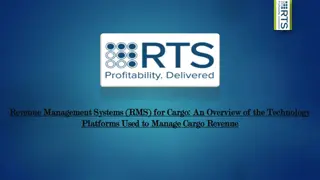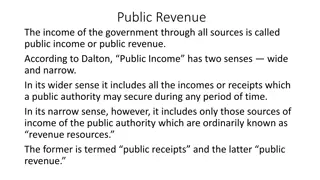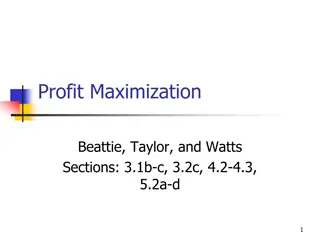Understanding Revenue Concepts in Different Market Conditions
Explore revenue concepts like Total Revenue (TR), Marginal Revenue (MR), and Average Revenue (AR) along with elasticity of demand in various market structures such as perfect competition, monopoly, monopolistic competition, and oligopoly. Learn about short and long-run equilibrium conditions and the significance of price discrimination in the market. Gain insights into the relationship between AR, MR, and elasticity of demand.
Download Presentation

Please find below an Image/Link to download the presentation.
The content on the website is provided AS IS for your information and personal use only. It may not be sold, licensed, or shared on other websites without obtaining consent from the author. Download presentation by click this link. If you encounter any issues during the download, it is possible that the publisher has removed the file from their server.
E N D
Presentation Transcript
SEMESTER-II B.COM GENERAL Subject: Principles of Economics Paper Code: CHG GE-2 KALIYAGANJ COLLEGE 2020
MARKET FOR COMMODITIES Sandeep Sundas Assistant Professor Dept. Of Economics Kaliyaganj College. Whatsapp No- 7063082473
Market for Commodities Revenue concepts under different market conditions: TR, MR and AR. Relations between AR, MR and Elasticity of demand. Perfect competition- short and long run. Supply curve in the short run (shut down and break even concepts) Monopoly-short and long run. Concept of price discrimination. Monopolistic competition, oligopoly market- short and long run equilibrium.
Revenue concepts under different market conditions: TR, MR and AR Revenue : is defined by R=PQ where P is the price and Q is the quantity sold. Suppose a commodity price is Rs. 5 and the units of the commodity sold is 100 units, therefore Revenue R is 5*100= 500. Average Revenue: AR is defined by the revenue per unit of output. AR= R/Q. AR is the price in the market condition. Marginal Revenue: MR is defined by change in revenue due to change in the quantity sold. MR= dR/dQ. Elasticity of demand : is the responsiveness of the change in the demand due to the change in its price. Elasticity of demand is divided into three they are as follows a. Price elasticity of demand: Change in the demand due to the change in the price of the commodity. b. Income elasticity of demand : change in the demand due to the change in the income. c. Cross elasticity of demand: is the responsiveness in the quantity demanded of one good when the price for another good changes.
Relations between AR, MR and Elasticity of demand
Perfect Competition There are large number of buyers and sellers in the market. They produce homogenous product. There is free entry and exit. The buyers and sellers have a perfect knowledge of the market conditions. The labours are mobile.
Perfect competition Short run. In the short run, the firm may earn Super normal profits, normal profits or losses. The condition for equilibrium in the short run are MC= MR MC must cut the MR from below. a. b.
Short run equilibrium- perfect competition
Perfect competition Long run The firms earn normal profits in the long run. The equilibrium condition of firm under long run is i) MC=MR ii) MC is increasing. a. From Loss to Normal Profit: many firm will leave the market, as a result there will be decrease in supply and price goes up. Factor price of production goes down and AC curve goes down and normal profits are observed. b. From super normal profits to normal profit New firms enter the market, the supply increases and prices will fall. The demand for factors of production goes up and cost curve shifts upward where normal profits are observed.
Long run equilibrium- perfect competition.
Monopoly market Monopoly market is a market structure where there is single seller and many buyers. There are barriers to entry. They are known as price makers. They can fix both price and quantity but not both simultaneously.
Monopoly market- short run equilibrium
Monopoly market long run equilibrium
Price Discrimination Developed by AC Pigou. There are three degrees of price discrimination: a. 1stDegree: Monopoly seller of output to know the maximum price the consumers are willing to pay. b. 2ndDegree: Price varies as quantity demanded. c. 3rdDegree: Charging different prices to different consumer groups.
Monopolistic competition The characteristics of monopolistic competition is as same as perfect competition except the homogeneity character but monopolistic market produces somewhat differentiated product.
Oligopoly market structure Oligopoly is a market structure where there are few sellers more than one. Few sellers Interdependence Prevalent advertising Barriers to entry Product differentiation. Examples are: automobiles, oil and gas, steel industry, airlines etc.
Price leadership Low cost firms Dominant firms which produces maximum output in proportion to total output. Barometric price leadership . Exploitative and aggressive price leadership.
Thank you PAPER TAUGHT BY Sandeep Sundas Assistant Professor Dept. Of Economics Kaliyaganj College. Whatsapp No- 7063082473























